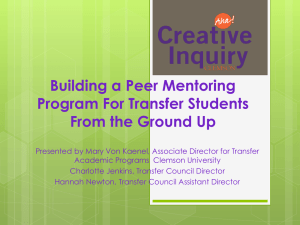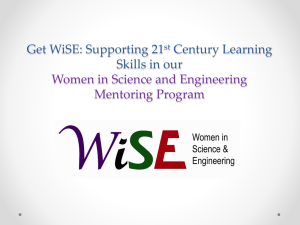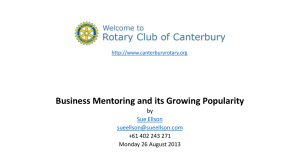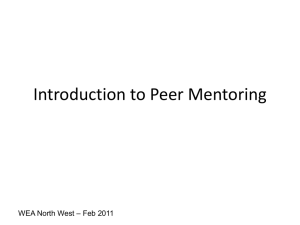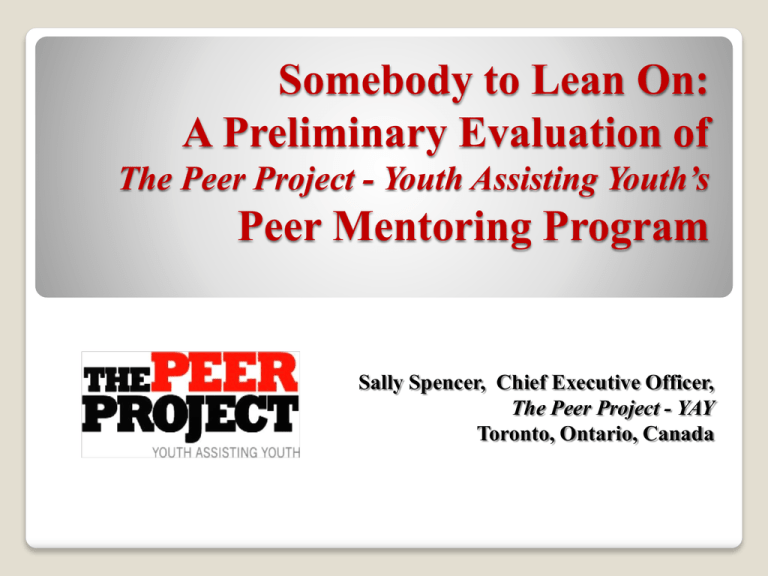
Somebody to Lean On:
A Preliminary Evaluation of
The Peer Project - Youth Assisting Youth’s
Peer Mentoring Program
Sally Spencer, Chief Executive Officer,
The Peer Project - YAY
Toronto, Ontario, Canada
Introduction
• The Peer Project | YAY –
a non-profit organization that
provides a youth peer
mentoring service to improve
the life prospects of at- risk
children
Peer Mentoring – a twofold
conceptualization: risk and
resiliency within a prevention
framework
•
•
Post test methodological
design evaluation to explore
if the program fosters
resiliency in youth
Purpose
The purpose of this project was threefold:
Explore YAY’s ability to foster resiliency in youth
Determine mentees' degrees of resiliency
Create a knowledge base of preliminary results to inform the
future development of the program
The Peer Project | YAY
•
•
•
•
•
•
•
Has served more than 30,000 young people since 1976
Currently services approximately 1500 children and youth per
month
Matches youth volunteers, ages 16 to 29, with at-risk children, ages
6 to 15, experiencing a variety of mental health related issues
Every referred youth has been clinically diagnosed as suffering
from at least 1 mental health related issues
Referrals - through child welfare agencies, schools, settlement
services
Home Assessments- completed by staff Social Workers for every
Mentee and Mentor in the program
Mentors are recruited from high schools, colleges, universities and
the workplace
Mandatory Mentor Orientation and
Training Sessions
Workshops include:
Strength-Based Mentoring
Child Abuse Awareness
Cultural Diversity
Child Engagement &
Management Skills
Bullying
Effective Communication
Other topics include: Roles
& Responsibilities;
Expectations; Cross-Cultural
Communication.
The Match
•
Matches (Mentor & Mentee) are based on common interests,
identified special needs, gender and geographical location
•
The duration of the mentoring relationship is a minimum of one
year. However, many matches go well beyond this specified
time frame
•
Participants spend an average of 3 hours per week together in a
variety of shared interest activities
•
Social Workers, Parent Support Workers and Volunteer Support
Workers provide ongoing support and supervision throughout
the duration of the relationship
Peer Mentoring within a Resiliency Framework
•
Most risk reduction programs focused
on the development of effective coping
strategies for youth (Osgood, Johnston,
O’Malley, & Bachman, 1988)
•
New research proposed the inclusion
of protective factors alongside the risk
reducing preventative interventions
(Pollard, Hawkins, & Arthur, 1999)
•
Resiliency enhancing programs:
protective factors counterbalance risk
factors and create emotionally resilient
children (Alperstein & Raman, 2003)
The Resiliency Framework
It focuses on the individual’s ability to:
•
Successfully navigate through significant threats (Hall, Vine &
Gardner, 2010)
•
Develop the necessary skills to overcome diversity (Goldstein
& Brooks, 2005) via a combination of external (family, peer,
school, community) and internal strengths (personality
characteristics, empowerment, self-control)
•
Mobilize protective resources to counterbalance risks (Rew &
Horner, 2003) and deal with stress effectively (Alperstein &
Raman, 2003)
The Resiliency Framework
An ecological (Bronfenbrenner, 1979) and comprehensive
approach to risk (Alperstein & Raman, 2003)
It posits that multi-layered interactions exist between the
individual and its surrounding environment, comprised of risk
factors but also of shielding factors (Fergus & Zimmerman,
2005) enhancing one's healthy development (Henley, 2010)
and individual well being (Resiliency Initiatives, 2012;
Steinebach & Steinebach, 2009; Saewyc, Skay, & Pettingell,
2006)
The Resiliency Framework
Youth with high resiliency factors
are:
•
Less likely to be involved in risk
taking activities such a substance
use and school misbehaviour
(Catalano, Berglund, Ryan,
Lonczack, & Hawkins, 2004)
•
More likely to develop
interpersonal skills, self control,
problem solving and cognitive
competencies (Catalano, Berglund,
Ryan, Lonczack, & Hawkins,
2004)
•
More likely to engage in
constructive behaviours
(Resiliency Initiatives, 2012)
Resiliency Based Paradigms
•
Seek to identify protective, nurturing factors in the lives of those
who otherwise would be expected to be at risk for a variety of
adverse outcomes (Coie, Watt, West, Hawkins, Asarnow,
Markman, Ramey, Shure & Long, 1993)
•
Promote emotional well being (Alperstein & Raman, 2003) as a
key component to mental health promotion for youth (Wyn,
Cahill, Holdsworth, Rowling & Carson, 2000)
•
Have been adopted as viable evaluation models for
understanding the major components contributing to the
resiliency development and well-being of children and youth in
our communities (Donnon & Hammond, 2007)
Methodology
Research Advisory Committee (RAC) of:
Front line service providers
Program participants
Experts within the Youth Development
Field
Experts within the Mentoring field
The RAC guided the project’s
development and reviewed its Internal
Ethics Protocol
Methodology
Evaluation Questions: Process and Outcome
•
The Process Evaluation questions aimed to shed light on the
mentoring relationship
•
The Outcome Evaluation questions explored youth resiliency
profiles as they particularly relate to their behavioural and
social functioning
Although feedback from both Mentors and Mentees was
elicited, within the context of this report, Mentees' opinions
are the ones primarily accounted for
Methodology
•
Participants were asked to complete the Child/Youth Resiliency:
Assessing Developmental Strengths (C/YR: ADS) tool at post
test, after they have been involved in the program for 1 year
•
Recruitment: a convenience sample limited to youth, ages 6 to
15, participating in YAY’s Peer Mentoring program
•
Informal focus group discussions were conducted with both,
mentees and mentors, following the administration of the tool
•
Questionnaires were carried out between June and August 2012
The C/YR:ADS tool
Previously tested for reliability and validity
(Donnon & Hammond, 2007)
Questionnaire items:
• External Developmental Strengths (family supports, peer
relationships, commitment to learning, school culture, community
cohesiveness)
• Internal Developmental Strengths (cultural sensitivity, self-control,
empowerment, self-concept, social sensitivity)
• Personal Core Character Competencies (strengths based aptitude,
emotional competence, social connectedness, moral directness,
adaptability, managing ambiguity, agency and responsibility)
• Demographic Information (age and sex)
• Progress Questions - to assess the overall mentoring relationship
Summary of Participants
The majority of Mentees were young males, with an
average age of 13 years, ranging between 10 to 16 years old
Mentees' Aggregated
Resiliency Scores
Participation in the YAY’s Peer
Mentoring program was beneficial for
youth:
•
73% of Mentees developed resilient
profiles: over a half of participants
(53%) reported a very resilient profile
and a further 20% reported a
somewhat resilient profile
•
Roughly ¼ of participants fit within a
vulnerable profile (26.7%)
•
No mentees fell into the Very
vulnerable category
Mentees’ External Developmental Strengths
•
Family support (79%): caring, communicative family; parents
as role models, actively involved in school matters and having
high academic expectations of their children
•
Peer relationships (78%)
•
Commitment to learning (70%): school engagement and
academic achievements
•
Positive school culture (68%): strong bond with a caring school
climate and high academic expectations
•
Community cohesiveness (58%): community values, adult
relationships within the community, neighbourhood boundaries
and the overall characteristic of a caring neighbourhood
Mentees’ Internal Developmental Strengths
•
Self control (85%): youth restraint &
resistance skills
•
Self concept (80%): self efficacy, selfesteem, planning and decisions making
capacity
•
Social sensitivity (79%): empathy, caring,
equality and social justice
•
Cultural sensitivity (68%): cultural
awareness, spirituality and acceptance
•
Empowerment (65%)
Mentees’ Core Competencies
•
Moral directedness (81%)
•
Social connectedness (80%)
•
Agency and responsibility (78%)
•
Managing ambiguity (77%)
•
Strength based aptitude (65%)
•
Emotional competence (63%)
Mentors’ Profiles
Similar profiles have been reported by the mentors
High scores among internal and external strengths and core
competencies were indicative of The Peer Project as
facilitating the development of resiliency characteristics
among mentors
The Mentoring Relationship
All mentees perceived their
mentors as being fully
involved, considerate, and
felt they were well matched
with their mentors
93% of participants stated
they would like to continue
their relationship with their
mentors in the future
The Mentoring Relationship
Benefits of the mentoring relationship included:
Feeling heard and respected
Getting along with their mentors
Talking about relevant concerns
Having the mentors take interest in their issues
Focusing on strengths rather than challenges
Being a positive influence in their life and helping them
achieve successful goals
Mentees’ Comments
Indicative of their positive mentoring
relationship:
•
"Like having a brother I never had“
•
"Now I know what it means to have a
positive influence"
•
"He helps me get thorough the tough
things"
•
" I liked going to the library and getting
my own library card and then finding
books together"
Mentors’ Comments
Mentors positively commented about their overall mentoring
experience:
" Developing this interesting relationship, you become a
brother and sister"
"It's a good experience. Helps a lot to be sensitive, choose
your words, learn how to make someone else happy...it's a
gratifying feeling"
Conclusions
•
The Peer Project |YAY facilitates the development of resiliency in
youth
•
73% of mentees have developed resilient profiles
•
Family support was the external development strength that
contributed the most to mentees' resiliency
•
Community cohesiveness was the least reported external strength
for all mentees. YAY intends to introduce new ways of building
community cohesiveness, perhaps by developing and engaging
youth in many more community and neighbourhood based
activities and events
Lower scores were reported on the cultural
sensitivity and empowerment internal strengths,
areas in which YAY plans to improve upon
•
Conclusions
Although no Mentees fell into the very vulnerable
category, more work is indeed needed to fully cater and
adapt the program to fit the needs of all participants, in
particular to assist youth in strengthening the internal
components of cultural sensitivity and empowerment, as
well as the external component of community
cohesiveness
Limitations
Although reflective of positive trends, these results can only
be validated with a pre-test/ post-test comparative evaluation.
The number of participants was fairly low, making it difficult
to generalize on the experiences of only 15 participants
THANK
YOU


![A Second One Makes More Winners [PowerPoint]](http://s2.studylib.net/store/data/005385576_1-a082553ee774a82b72d9cc299026ef50-300x300.png)
